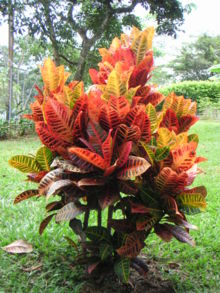This is an old revision of this page, as edited by 2001:8003:a015:bc01:c0a2:9d45:bd4d:c2b2 (talk) at 05:34, 15 June 2015. The present address (URL) is a permanent link to this revision, which may differ significantly from the current revision.
Revision as of 05:34, 15 June 2015 by 2001:8003:a015:bc01:c0a2:9d45:bd4d:c2b2 (talk)(diff) ← Previous revision | Latest revision (diff) | Newer revision → (diff)
| Codiaeum variegatum | |
|---|---|

| |
| Scientific classification | |
| Kingdom: | Plantae |
| (unranked): | Angiosperms |
| (unranked): | Eudicots |
| (unranked): | Rosids |
| Order: | Malpighiales |
| Family: | Euphorbiaceae |
| Genus: | Codiaeum |
| Species: | C. variegatum |
| Binomial name | |
| Codiaeum variegatum (L.) A.Juss. | |
Codiaeum variegatum ("garden croton" or "variegated croton"; syn. Croton variegatum L.) is a species of plant in the genus Codiaeum, which is a member of the family Euphorbiaceae. It is native to Indonesia, Malaysia, Australia, and the western Pacific Ocean islands, growing in open forests and scrub. It is an evergreen shrub growing to 3 m tall and has large, thick, leathery, shiny evergreen leaves, alternately arranged, 5–30 cm long and 0.5–8 cm broad. The inflorescences are long racemes 8–30 cm long, with male and female flowers on separate inflorescences; the male flowers are white with five small petals and 20–30 stamens, the female flowers yellowish, with no petals. The fruit is a capsule 9 mm diameter, containing three 6 mm seeds. The stems contain milky sap that bleeds from cut stems.
The garden crotons should not be confused with Croton, a cosmopolitan genus also in the Euphorbiaceae, containing more than 700 species of herbs, shrubs and trees.
Cultivation

In tropical climates, crotons make attractive hedges and potted patio specimens, valued for their striking foliage. They only survive outdoors where temperatures do not normally drop below 10° to 13°C in winter; colder temperatures can cause leaf loss. In colder climates, the plants are grown in greenhouses or as house plants. The cultivated garden crotons are usually smaller than the wild plant, rarely over 1.8 m tall, and come in a wide diversity of leaf shapes and colours. They are sometimes grouped under the name Codiaeum variegatum var. pictum (Lodd.) Müll. Arg., though this is not botanically distinct from the species and usually treated as a synonym of it.

There are several hundred cultivars, selected and bred for their foliage. Depending on the cultivar, the leaves may be ovate to linear, entire to deeply lobed or crinkled, and variegated with green, white, purple, orange, yellow, red or pink. The colour patterns may follow the veins, the margins or be in blotches on the leaf. Popular cultivars include 'Spirale' which has spirally-twisted red and green leaves; 'Andreanum' which has broadly oval yellow leaves with gold veins and margins; 'Majesticum' which has pendulous branches, with linear leaves up to 25 cm long with midrib veins yellow maturing to red; and 'Aureo-maculatum' which has leaves spotted with yellow.
Precautions
As with many of the Euphorbiaceae, the sap is toxic and can cause skin eczema in some people. It is also toxic if eaten, though in small quantities, it has been used in herbal medicine to treat gastric ulcers.
References
- ^ Flora of China: Codiaeum variegatum
- ^ Huxley, A., ed. (1992). New RHS Dictionary of Gardening 1: 665. Macmillan.
- http://bie.ala.org.au/species/urn:lsid:biodiversity.org.au:apni.taxon:427826
- National Tropical Botanical Garden Codiaeum variegatum (Euphorbiaceae)
- Occupational contact dermatitis due to croton (Codiaeum variegatum (L.) A. Juss var. pictum (Lodd.) Muell. Arg.). Sensitization by plants of the Euphorbiaceae. Contact Dermatitis 1977 Dec. 3(6): 289-92. abstract.
- Ogunwenmo, K. O. et al. (2007). Cultivars of Codiaeum variegatum (L.) Blume (Euphorbiaceae) show variability in phytochemical and cytological characteristics. African Journal of Biotechnology 6 (20): 2400-2405. pdf article.